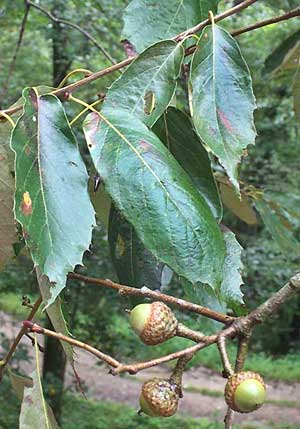Excerpts from Jim Conrad's
Naturalist Newsletter
from the November 5, 2007 Newsletter issued from Yerba Buena Clinic just outside Pueblo Nuevo Solistahuacan, Chiapas, MÉXICO
about 1740 meters in elevation, ± LAT. 17° 11' 27"N, LONG. -92° 53' 35"W
QUERCUS CALOPHYLLA
As one ascends or descends mountain slopes, vegetation zones continually change. Researchers have named the particular forest type I'm living in as Pine-Oak-Sweetgum because those are the dominant tree species. I've added a description of the forest type, including a list of other woody species also found in it, here.
At my elevation at the forest zone's lowest limit, about 1740 meters, the main oak is the broad-leafed, sharp-toothed one shown below.

I think that that's QUERCUS CANDICANS*, "candicans" meaning "white," referring to the leaves' undersurfaces which are covered with a dense, woolly, fuzzy-feeling surface of tiny, branched, matted hairs, very much like the north's Black-oak leaves.
This is a humid forest so tree trunks and limbs are often very heavily mantled with bromeliads, ferns, orchids and other epiphytic species. Note that these are not parasitic. They do not rob host trees of nutrients. They only grow upon the limbs. You can see a nice bunch of bromeliads inside our tree right above my outdoor toilet on a rainy, foggy day below:
